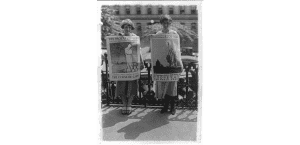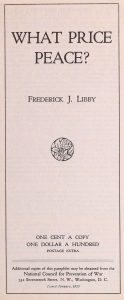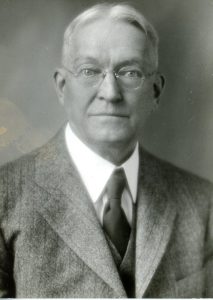What Price Peace?
By Becky Chapin, Archivist
Peace is intangible…The members of a Council learn to get along with other people and their views. They learn to harmonize their views with those of other people. – Jack Kerridge, 1938.
In 1936, the Emergency Peace Campaign (EPC) was organized by members of the American Friends Service Committee (a Quaker organization). Alarmed by increasing economic tensions in Europe, namely the Italian invasion of Ethiopia (1935) and Spanish Civil War (1936-1939), the group was dedicated to publicizing the events that were happening to warn of a possible new world war.
The Geneva Unit traveled to many cities to participate in the EPC Peace Institutes that were organized across the US. Though the original campaign was dissolved, in its place the National Peace Conference (NPC) was formed.
With headquarters in New York, the NPC spawned several branches within the state. The Geneva Peace Council held its first meeting in August 1937. It stated its main function was to provide education in peace matters by sponsoring diverse activities to further the cause of peace in Geneva and the world, promoting legislative action against congressional bills which threaten peace, and educating on international matters and their relation to maintaining peace.
The goal was certainly a heavy one. Interest from other organizations and individuals gained the Geneva Peace Council members. Most of the local churches sent a delegate, Hobart College and William Smith College each sent a delegate, and several local clubs sent interested parties including from the Woman’s Club, YMCA, League of Women Voters, Social Service League, and the Community Chest. Also included were student representatives. HWS college students began selling peace bonds provided by the National Council for the Prevention of War around 1936 and hosted many discussions on peace. In 1939, HWS students formed a permanent HWS Peace Council to sustain interest in peace action on both campuses.
The first action the GPC took was to recommend a moving picture called The Road Back. Haven’t heard of it? It was a sequel to All Quiet on the Western Front. While the latter focused on the realistic portrayal of war, the former realistically portrayed the return of those soldiers to their homes only to find complete devastation of property and morale.
The Geneva Peace Council was able to host a number of speakers as they traveled through the area in addition to locals. One of their first speakers in February 1938 was Jack Kerridge, a member of the Rochester Peace Council and chairman of the University of Rochester Peace Institute. He discussed peace problems within the United States, specifically in North Carolina and Tennessee. In North Carolina in 1937, the campus hosted the Imperial Wizard of the Ku Klux Klan who spoke to the gathered white students and faculty about the need for white supremacy. Alternatively, Tennessee was experiencing a rise in Communists and Communist sympathizers in the same year.
As an instructor of citizenship at Hobart College, Carl Taylor outlined the GPC program to the students at HWS in 1938. Attorney Thomas J Cleere led a discussion on universal conscription. Noted lecturer Paul Harris Jr., a staff member of the National Council for the Prevention of War (NCPW), spoke on the NCPW several times in Geneva during the 1930s.
A non-partisan group, the NCPW advised members of Congress on many angles of the peace problem while reaching across the country to educate people on peace issues and legislation affecting them. Carl Taylor led a discussion on Neutrality Legislation, one he believed was an isolation measure rather than a neutrality law. Several attendees felt the law did not keep America out of war, rather it would only delay our entrance.
Jeanette Rankin, the first female member of Congress after her election in Montana in 1916, spoke in 1939 at the Geneva High School. Rankin’s first vote was to cast against the entrance of the United States into The Great War. A lifelong pacifist, she would go on to cast the only vote against the declaration of war on Japan.
In April 1938, Geneva hosted the Upstate Peace Conference. Attendees from Geneva, the Catskills, Canandaigua, Rochester, Penn Yan, and Syracuse gathered to listen to the objectives of the Keep America Out of War Congress. The Congress pursued a minimum six-point peace program which included the removal of US ships and nationals from belligerent zones, a war referendum, abandoning conscription and industrials mobilization, and greater economic and social justice at home and abroad.

Miss Goldie Dunn and Miss Louise Hiatt, of the National Council for the Prevention of War, holding isolationist posters. Photo courtesy of the Library of Congress.
At the end of the conference, the attendees adopted several resolutions. Through the Keep America Out of War Congress program, they would continue promote peace through their local councils, send delegates to the Anti-War Congress the following month, and call on their senators and congressmen to oppose the Vinson-Walsh super-navy bill. The peace conference attendees believed putting the bill in motion would promote war instead of peace and place billions of dollars in an unproductive and uneconomic enterprise. The 8.5 billion dollar program would eventually increase the size of the American combat fleet in 1940.
There are no other records I could find after 1939 in Geneva, so it’s likely the Geneva Peace Council dissolved shortly after.
References
Swarthmore Peace Collection records, National Council for Prevention of War; Keep America Out of War Congress
MU Local History Projects, Emergency Peace Campaigns
What Price Peace? National Council for Prevention of War pamphlet. Available on Project Gutenberg.



Thank you Becky,
I didn’t know that there were Peace Councils all over the country and in particular in NY State and in Geneva, a very active one. Quite interesting article.
The GPC might have thought in 1939 that the US was not going to get involved in WWII.
But it all changed in 1941 and Pearl Harbor.